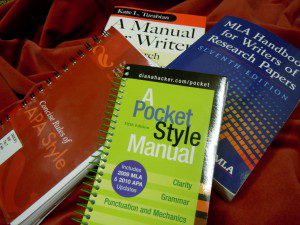 Much of what I do with my clients’ writing falls into the category of “copyediting.” It is a technical term, so I’ll give a brief explanation of what it means and what it doesn’t.
Much of what I do with my clients’ writing falls into the category of “copyediting.” It is a technical term, so I’ll give a brief explanation of what it means and what it doesn’t.
One of the primary jobs of a copyeditor is to make sure that the manuscript conforms to a particular editorial style, also known as a house style. Many writers have some familiarity with one or more editorial styles, such as those of the American Psychological Association (APA), Modern Language Association (MLA), Chicago Manual of Style (CMS), and Council of Science Editors (CSE). Businesses, news organizations, publishers and many other institutions also have in-house style guides to ensure clarity and consistency. Editorial style includes such elements as spelling, capitalization, hyphenation, punctuation, how to handle numbers, use of abbreviations, when to use bold type and italics, and citation. Editing to conform to a style is usually called mechanical editing.
A copyeditor also works to correct errors or lapses in grammar, syntax, usage, and diction. This kind of work is often referred to as language editing. Language editing involves more editorial judgment than mechanical editing. Much depends on context, intended audience, changes in usage, and the author’s style – so a conscientious editor keeps these factors continuously in mind, and remains faithful to the author’s intentions.
Another responsibility of a copyeditor is to look for and point out inconsistencies within the manuscript, as well as organizational or structural problems. These tasks are grouped under the term content editing. If a fact or a claim in one part of the document is contradicted in another part, or if there is an obvious factual error, the copyeditor brings it to the author’s attention. The copyeditor also notes when the organization or structure contributes to confusion or inefficiency. Content editing usually means making note of the problems and making suggestions rather than immediate editorial changes.
Copyediting is distinct from proofreading. Although a copyeditor, as a matter of course, corrects or points out whatever might be amiss in the manuscript, they will not be able to catch every detail. Also, copyediting is followed by authorial revision, so errors might be introduced at that stage. It is essential to have at least one final fresh pair of eyes that go over the manuscript, line by line, before it is published or submitted.
It is also distinct from developmental editing. I noted earlier that when a copyeditor finds organizational or structural problems, they make suggestions rather than changes. Making these kind of wholesale revisions is developmental editing.
Most importantly, a copyeditor isn’t a writer, rewriter or ghostwriter. A copyeditor is there to improve the writing, not to create it. This is especially important when working with academic manuscripts. Crossing this line in academic work means plagiarism.
Look for my upcoming post on editing levels. It will help you in communicating your intentions to your editor.
No Comments